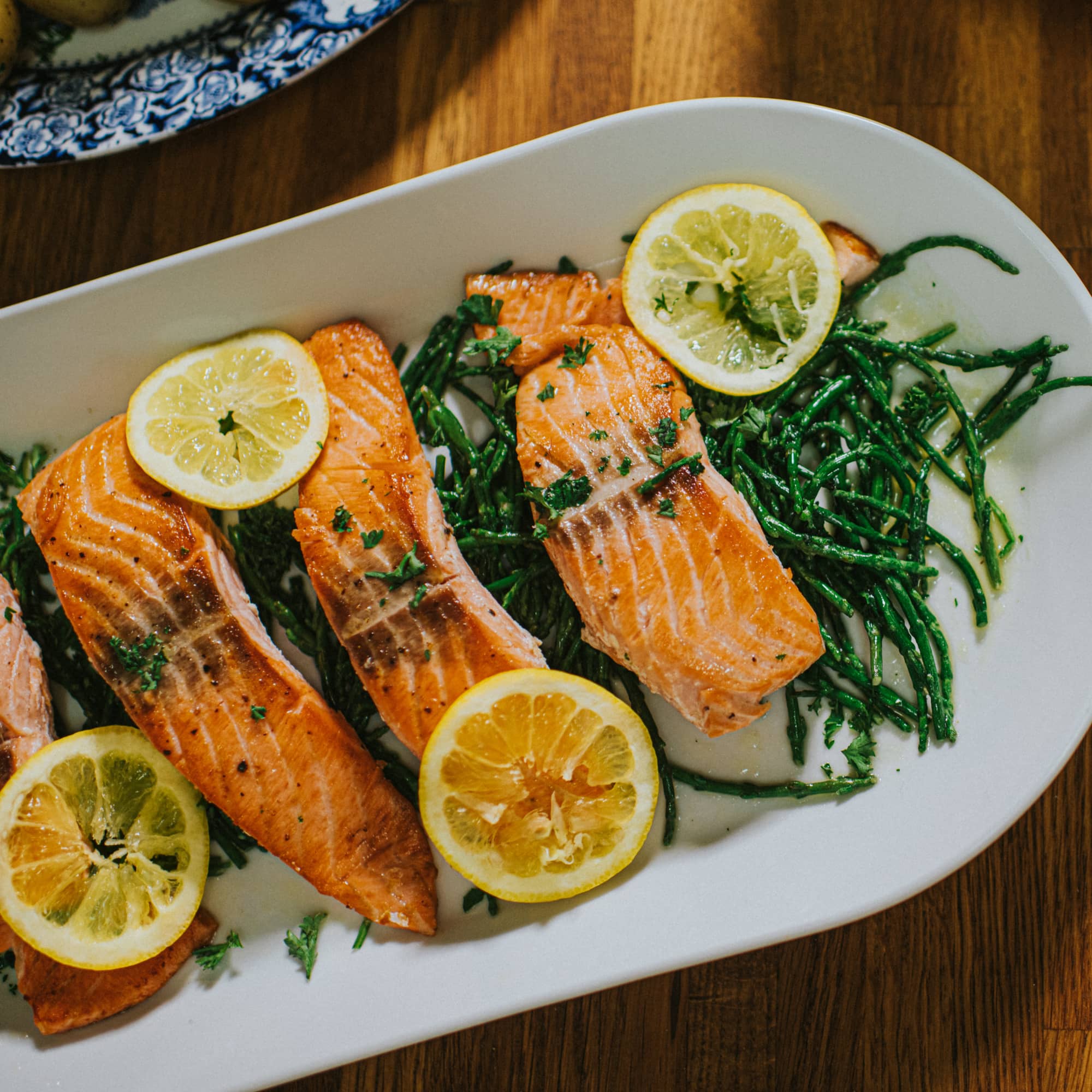
- POPSUGAR Australia
- Fitness
- Up Your Omega-3 Intake With These 14 Foods
Up Your Omega-3 Intake With These 14 Foods

Omega-3 fatty acids are a category of healthy fatty acids that help form the structures of cell membranes, provide energy for the body, and support heart health. To experience these benefits, the Institute of Medicine recommends adults take in between 1.1 and 1.6 grams of omega-3 fatty acids every day, depending on factors like a person’s age and pregnancy status. There are various types of omega-3 fatty acids, however, the big three to keep an eye out for are alpha-linolenic acid (ALA), eicosapentaenoic acid (EPA), and docosahexaenoic acid (DHA).
ALA can not be made by the body and is therefore considered to be an essential fatty acid that you can only obtain from specific foods in your diet. According to one study, ALA has also been shown to support brain health, and can potentially offer protection against age-related cognitive decline.
Small amounts of DHA and EPA can be synthesised in the body, but it’s still not enough to fuel the body with adequate amounts to do perform its necessary functions. Therefore, it is important to incorporate these fatty acids into your diet as well. DHA and EPA omega-3 fatty acids play particularly important roles during pregnancy, with one study showing that adequate intake of these two omegas have been linked to a slew of positive health outcomes, like reduced risk of developing postpartum depression and helping develop the baby’s cognitive and visual development.
Whether you’re trying to maximise your nutrients while you’re pregnant, or trying to just have a more balanced diet, eating enough omegas is always a good idea. To get your daily omega-3 boost, you should include foods that naturally contain this key nutrient in your diet every single day. Of course, if you have a hard time eating these foods consistently, a supplement can always be considered.
1. Walnuts
Walnuts are the only tree nut that is an excellent source of alpha-linolenic acid (ALA), a plant-based omega-3 essential fatty acid. A one-ounce serving of walnuts provides 2.5 grams of this fatty acid. Along with the healthy fats that these nuts provide, they also contain fiber, plant-based protein, and vitamins and minerals that support overall wellness.
2. Salmon
Salmon is one of the best sources of DHA and EPA omega-3 fatty acids, making it a fantastic food to eat when trying to get in those important omegas. Including salmon in a variety of recipes can be a simple way to ensure your body is being fueled with the DHA and EPA omega-3 fatty acids that it needs. A 3-ounce portion of salmon contains roughly 0.9 grams of DHA and 0.23 grams of EPA.
3. Oysters
Oysters can give your body a serious boost of EPA and DHA omega-3 fatty acids. Just remember to avoid eating them raw if you are pregnant to reduce your risk of experiencing a foodborne illness. 3 ounces of oysters contain 0.212 grams of DHA and 0.4 grams of EPA.
4. Caviar
These fish eggs are jam-packed with DHA and EPA omega-3 fatty acids. If you are a sushi lover, know that the fish roe found on the outside of your rolls is an excellent source of DHA and EPA omega-3 fatty acids too. 1 ounce of black and red caviar contains 1 gram of DHA and 0.78 grams of EPA.
5. Flax Seeds
Flax seeds are a plant-based source of ALA omega-3 fatty acids, making them a great addition to your oatmeal, smoothie, and bread recipes. Since the shell of the flaxseed can be hard for your body to absorb its nutrients, freshly ground flax seeds are often recommended. 1 tablespoon of flaxseeds contains 2.35 grams of ALA, per The National Institutes of Health.
6. Soybeans
Tofu, edamame, and roasted soybean snacks are all great sources of ALA omega-3 fatty acids. Leaning on soybeans as a protein source can fuel your body with this key fatty acid and fiber. ½ cup of frozen edamame contains 0.28 grams of ALA, per The National Institutes of Health.
7. Grass-fed Beef
Since grass is a natural source of omega-3 fatty acids, it makes sense that any animal that eats grass would also contain this fatty acid as well. Grass-fed beef contains healthy omegas along with key nutrients that many of us don’t get enough of in our diets, including iron and zinc. The amount of omega 3s provided by grass-fed beef can vary based on various factors.
8. Spinach
Spinach may be known for its vitamin and mineral content, but this low-calorie veggie is also a great plant-based source of omega-3 fatty acids. Combining some cooked spinach with a piece of baked fish will give your body a well-rounded and balanced meal containing a variety of omega-3 fatty acids. ½ cup of cooked spinach contains 0.83 grams of ALA omega-3s.
9. Hemp Seeds
No matter whether they are sprinkled on your avocado toast, added to your salad, or included in your smoothie, enjoying hemp seeds can give you some important plant-based ALA omega-3s. Although these seeds won’t give you as much of this healthy fat as flax seeds, they can still be a healthy addition to your diet that can give your dishes a satisfying, nutty taste. 3 tablespoons of hemp seed contains 2.6 grams of ALA.
10. Chia Seeds
Chia seeds are jam-packed with fiber, iron, calcium, and a slew of other key nutrients. Simply adding these tiny seed to your dishes will help you meet your quota for omega-3 fatty acids. It should be noted that eating chia seeds that are freshly ground may help your body absorb more ALA omega-3 fatty acids, so consider taking that extra step if you want to maximise your omega-3 fatty acid intake. 1 ounce of chia seeds contains 5 grams of ALA, per The National Institutes of Health.
11. Avocado
As if we need another reason to love avocados! This fruit is a natural source of ALA omega-3 fatty acids. While it doesn’t contain a huge amount of this key fatty acid, it offers up more than other fruit varieties. Adding avocados to your dishes is no sacrifice, as most of us are already sold on enjoying dishes like guacamole and smoothies that have this fruit. One-half of a medium avocado contains 0.112 gram of ALA per The National Institute of Health.
12. Sardines
Sardines are jam-packed with DHA and EPA omega-3 fatty acids. And since they are lower on the seafood food chain, sardines have a lower methyl mercury content compared to other fish choices (making them an excellent omega-3 choice for pregnant people). 3 ounces of sardines contain 0.74 grams of DHA and 0.45 grams of EPA, per The National Institutes of Health.
13. Shrimp
If you are more of a shellfish lover than a fish aficionado, know that you can get some DHA and EPA omegas from eating foods like shrimp. To get more shrimp in your diet, try out a shrimp curry stir fry or a delicious honey garlic shrimp dish one night this week. 3 ounces of shrimp contains 0.12 grams of both DHA and EPA omega-3 fatty acids, per The National Institutes of Health.
14. DHA Fortified Orange Juice and Milk
Certain orange juice and milk manufacturers are now adding DHA to their products to help people get in this crucial nutrient in a simple way. The addition doesn’t affect the taste of the popular fridge staples, but it helps people who don’t eat a ton of fish. The amount of DHA omega-3 fatty acids found in these products varies depending on the manufacturer.


